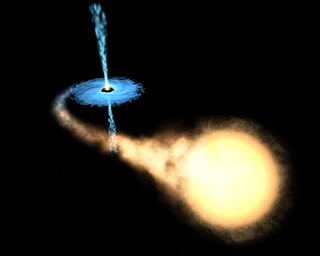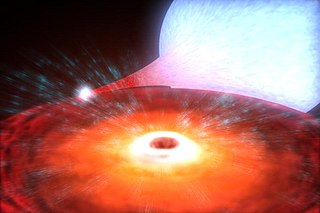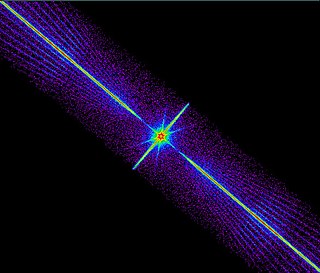Related Research Articles

A quasar is an extremely luminous active galactic nucleus (AGN). It is pronounced KWAY-zar, and sometimes known as a quasi-stellar object, abbreviated QSO. This emission from an AGN is powered by a supermassive black hole with a mass ranging from millions to tens of billions of solar masses, surrounded by a gaseous accretion disk. Gas in the disc falling towards the black hole heats up because of friction and releases energy in the form of electromagnetic radiation. The radiant energy of quasars is enormous; the most powerful quasars have luminosities thousands of times greater than that of a galaxy such as the Milky Way. Usually, quasars are categorized as a subclass of the more general category of AGN. The redshifts of quasars are of cosmological origin.

Cygnus X-1 (abbreviated Cyg X-1) is a galactic X-ray source in the constellation Cygnus and was the first such source widely accepted to be a black hole. It was discovered in 1971 during a rocket flight and is one of the strongest X-ray sources detectable from Earth, producing a peak X-ray flux density of 2.3×10−23 W/(m2⋅Hz) (2.3×103 jansky). It remains among the most studied astronomical objects in its class. The compact object is now estimated to have a mass about 21.2 times the mass of the Sun and has been shown to be too small to be any known kind of normal star or other likely object besides a black hole. If so, the radius of its event horizon has 300 km "as upper bound to the linear dimension of the source region" of occasional X-ray bursts lasting only for about 1 ms.

X-ray binaries are a class of binary stars that are luminous in X-rays. The X-rays are produced by matter falling from one component, called the donor, to the other component, called the accretor, which is very compact: a neutron star or black hole. The infalling matter releases gravitational potential energy, up to several tenths of its rest mass, as X-rays. The lifetime and the mass-transfer rate in an X-ray binary depends on the evolutionary status of the donor star, the mass ratio between the stellar components, and their orbital separation.

A microquasar, the smaller version of a quasar, is a compact region surrounding a stellar black hole with a mass several times that of its companion star. The matter being pulled from the companion star forms an accretion disk around the black hole. This accretion disk may become so hot, due to friction, that it begins to emit X-rays. The disk also projects narrow streams or "jets" of subatomic particles at near-light speed, generating a strong radio wave emission.

Astronomy Picture of the Day (APOD) is a website provided by NASA and Michigan Technological University (MTU). According to the website, "Each day a different image or photograph of our universe is featured, along with a brief explanation written by a professional astronomer." The photograph does not necessarily correspond to a celestial event on the exact day that it is displayed, and images are sometimes repeated. However, the pictures and descriptions often relate to current events in astronomy and space exploration. The text has several hyperlinks to more pictures and websites for more information. The images are either visible spectrum photographs, images taken at non-visible wavelengths and displayed in false color, video footage, animations, artist's conceptions, or micrographs that relate to space or cosmology. Past images are stored in the APOD Archive, with the first image appearing on June 16, 1995. This initiative has received support from NASA, the National Science Foundation, and MTU. The images are sometimes authored by people or organizations outside NASA, and therefore APOD images are often copyrighted, unlike many other NASA image galleries.

Westerhout 50 (W50) or SNR G039.7-02.0, also referred to as the Manatee Nebula, is a supernova remnant located in the constellation Aquila, about 18,000 light years away. In its centre lies the micro-quasar SS 433, whose jets are distorting the remnant's shell. Most likely W50 and SS 433 are related objects, remnants from a supernova which occurred about 20,000 years ago.

Cygnus A (3C 405) is a radio galaxy, and one of the strongest radio sources in the sky. A concentrated radio source in Cygnus was discovered by Grote Reber in 1939. In 1946 Stanley Hey and his colleague James Phillips identified that the source scintillated rapidly, and must therefore be a compact object. In 1951, Cygnus A, along with Cassiopeia A, and Puppis A were the first "radio stars" identified with an optical source. Of these, Cygnus A became the first radio galaxy, the other two being nebulae inside the Milky Way. In 1953 Roger Jennison and M K Das Gupta showed it to be a double source. Like all radio galaxies, it contains an active galactic nucleus. The supermassive black hole at the core has a mass of (2.5±0.7)×109 M☉.
Cygnus X-3 is a high-mass X-ray binary (HMXB), one of the stronger binary X-ray sources in the sky. It is often considered to be a microquasar, and it is believed to be a compact object in a binary system which is pulling in a stream of gas from an ordinary star companion. It is one of only two known HMXBs containing a Wolf-Rayet star. It is invisible visually, but can be observed at radio, infrared, X-ray, and gamma-ray wavelengths.

The Veil Nebula is a cloud of heated and ionized gas and dust in the constellation Cygnus.
The Tolman–Oppenheimer–Volkoff limit is an upper bound to the mass of cold, non-rotating neutron stars, analogous to the Chandrasekhar limit for white dwarf stars. If the mass of a neutron star reaches the limit it will collapse to a denser form, most likely a black hole.
LS I +61 303 is a microquasar, a binary system containing a massive star and a compact object. The compact object is a pulsar and the system is around 7,000 light-years away.

LS 5039 is a binary system in the constellation of Scutum. It has an apparent magnitude of 11.27, and it is about 8,200 light-years away.

GRO J1655-40 is a binary star consisting of an evolved F-type primary star and a massive, unseen companion, which orbit each other once every 2.6 days in the constellation of Scorpius. Gas from the surface of the visible star is accreted onto the dark companion, which appears to be a stellar black hole with several times the mass of the Sun. The optical companion of this low-mass X-ray binary is a subgiant F star.

GRS 1915+105 or V1487 Aquilae is an X-ray binary star system which features a regular star and a black hole. It was discovered on August 15, 1992 by the WATCH all-sky monitor aboard Granat. "GRS" stands for "GRANAT source", "1915" is the right ascension and "105" reflects the approximate declination. The near-infrared counterpart was confirmed by spectroscopic observations. The binary system lies 11,000 parsecs away in Aquila. GRS 1915+105 is the heaviest of the stellar black holes so far known in the Milky Way Galaxy, with 10 to 18 times the mass of the Sun. It is also a microquasar, and it appears that the black hole rotates at least 950 times per second, close to the maximum of 1,150 times per second, with a spin parameter value between 0.82 and 1.00.

XTE J1650-500 is a binary system containing a stellar-mass black hole candidate and 2000–2001 transient binary X-ray source located in the constellation Ara. In 2008, it was claimed that this black hole had a mass of 3.8±0.5 solar masses, which would have been the smallest found for any black hole; smaller than GRO 1655-40, the then known smallest of 6.3 M☉. However, this claim was subsequently retracted; the more likely mass is 5–10 solar masses.

1E1740.7-2942, or the Great Annihilator, is a Milky Way microquasar, located near the Galactic Center on the sky. It likely consists of a black hole and a companion star. It is one of the brightest X-ray sources in the region around the Galactic Center.

XTE J1550-564, sometimes abbreviated to J1550 and also known as V381 Normae, is a low-mass X-ray binary in the constellation Norma. It is composed of a black hole around 10 times as massive as the Sun, and a star of spectral type K3III. The black hole fires out jets of matter that are thought to arise from an accretion disk, and is hence known as a microquasar.

XTE J1118+480 is a low-mass X-ray binary in the constellation Ursa Major. It is a soft X-ray transient that most likely contains a black hole and is probably a microquasar.

ULAS J1342+0928 is the second-most distant known quasar detected and contains the second-most distant and oldest known supermassive black hole, at a reported redshift of z = 7.54. The ULAS J1342+0928 quasar is located in the Boötes constellation. The related supermassive black hole is reported to be "800 million times the mass of the Sun".
References
- 1 2 3 4 5 6 7 8 9 "Microquasars: compendium of characteristics". www.aim.univ-paris7.fr. Retrieved 19 January 2017.
- 1 2 3 4 5 6 "Micro Quasars". www.astrosurf.com. Retrieved 19 January 2017.
- ↑ "First Microquasar Found Beyond Our Milky Way". www.nrao.edu. Retrieved 19 January 2017.
- ↑ "Microquasar GRO J1655-40 (artist's impression)". www.spacetelescope.org. Retrieved 19 January 2017.
- ↑ "APOD: 2004 September 16 - Microquasar in Motion". apod.nasa.gov. Retrieved 19 January 2017.
- ↑ "Microquasar found in neighbor galaxy | Astronomy.com". Astronomy.com. Retrieved 19 January 2017.
